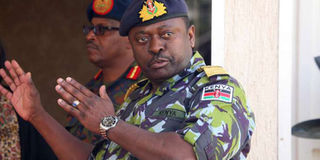When state clamps down on information, terrorists’ spin is the one that dominates

Kenya Defence Forces General Samson Mwathethe briefs journalists at Wilson Airport on January 18, 2016, after receiving more soldiers who were airlifted to Nairobi following an Al-Shabaab ambush in Somalia. We must find out why a camp supposed to be under maximum security night and day was breached so easily. PHOTO | EVANS HABIL | NATION MEDIA GROUP
What you need to know:
- Al-Shabaab could have claimed 63 kills, but there was no telling in the absence of bodies, and uncertainty over the number of survivors out somewhere awaiting rescue.
- True, it would be callous and distasteful for anyone to spread such pictures on Facebook, Twitter or any other social media platform, leave alone mainstream news outlets.
- Yes, we must hit back with extreme prejudice, sparing neither the attackers nor their support networks in both Kenya and Somalia.
We still have to see whether the Al-Shabaab attack on a KDF camp in El Adde turns out to be Kenya’s Black Hawk Down moment.
While accurate and reliable numbers on the fatalities are still hard to come by, it is clear that the Kenyan military incursion suffered a bloody nose with the brazen dawn attack last Friday, the biggest loss of men since Operation Linda Nchi was launched on October 2011.
Kenya was plunged into mourning for fallen soldiers for the first time since the operation to take the battle to the Al-Shabaab terrorists in the southern Somali lairs commenced more than four years ago.
We have in the past mourned civilian victims of terrorist attacks but this is the first time we are mourning on such a scale our men in uniform, all volunteers who take the bullets for the rest of us.
Kenya rightly united in mourning the slain soldiers, with both President Uhuru Kenyatta and Opposition leader Raila Odinga putting aside perpetual political feuds to release separate messages of solidarity with the gallant men who had made the ultimate sacrifice.
But even in moments of grief and sorrow, there must still be time for reflection.
Much too often in such situations, we want to be in denial, we want to cry undisturbed by hard truths.
We want to bury our heads in the sand and create the false narration that those asking inconvenient questions are unpatriotic traitors who do not feel for the victims.
PREVENTING RECURRENCE
Yet these questions must be asked, for it is only by establishing the truth can we design safeguards against recurrence.
It is only if we want to be mourning fallen comrades again and again that we will continue to comfort ourselves with outright lies and suppression of plain facts.
We saw those traits — on the part of government, media and citizens — with Garissa, with Westgate and now with the El Adde.
From the moment news began filtering out about the heavy casualties, officialdom clamped down on information, leaving Al-Shabaab to dominate with its own spin.
In the absence of contrary figures, the only body count available to Kenyans and the world at large was numbers put out by the terrorist propaganda mill, which could have been widely exaggerated, or maybe somewhere close to the truth.
One can appreciate that in such situations it is hellishly difficult, even for the military, to establish accurate numbers.
Al-Shabaab could have claimed 63 kills, but there was no telling in the absence of bodies, and uncertainty over the number of survivors out somewhere awaiting rescue.
But still, there are professional ways of managing information so that you do not end up looking like outright liars, and in the process lending credibility to the contrary information put out by the enemy.
This is what the military managed with its initial spin on the attack that from inception sounded so patently false.
Then there was Interior Cabinet Secretary Joseph Nkaissery, a man more attuned to diversionary Kanu-style threats rather than to the work he was appointed to do.
In the midst of the unfolding calamity, his priority was in purporting to direct the Inspector General of Police to arrest any persons who might share online images of slain Kenyan soldiers.
HITTING BACK
True, it would be callous and distasteful for anyone to spread such pictures on Facebook, Twitter or any other social media platform, leave alone mainstream news outlets.
But still, Gen (Rtd) Nkaissery’s arrest threats were totally out of place, both legally and in timing.
He should have directed his energies to ensuring that the Kenya military has all the resources it needs to strike the terrorists deep in their hideouts and teach them a lesson they will never forget.
Yes, we must hit back with extreme prejudice, sparing neither the attackers nor their support networks in both Kenya and Somalia.
But we must also find out why a camp supposed to be under maximum security night and day was breached so easily.
And we must also continue the conversation on what exactly we are doing in Somalia and whether the military operation needs to be reviewed.
Note that I don’t advocate a hasty pull-out; that would be retreat and surrender, and amount to victory for terrorism.
Macharia Gaitho is a former Managing Editor, Special Projects, for the Daily Nation. [email protected]





